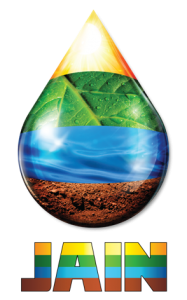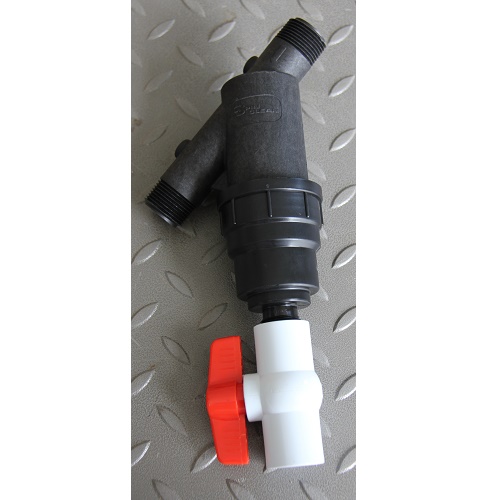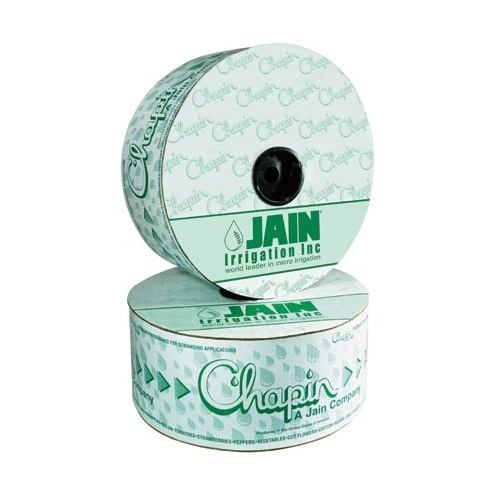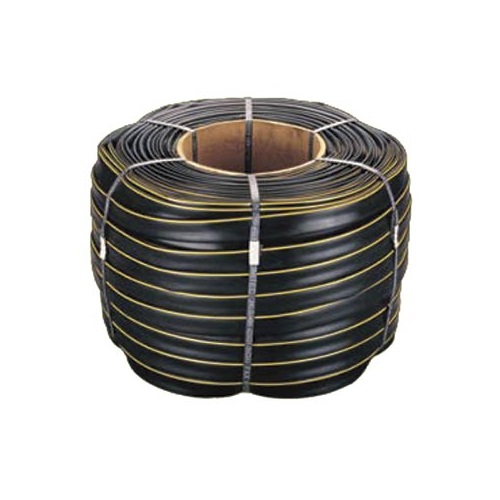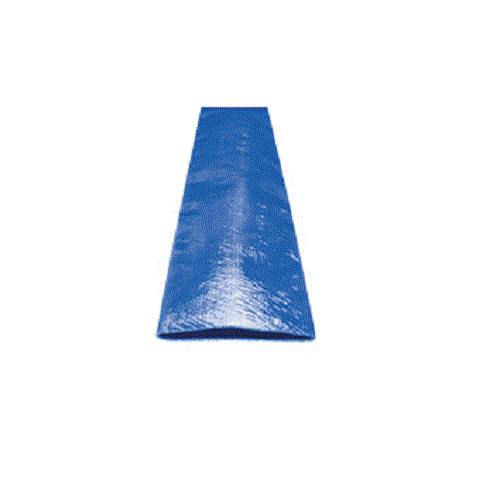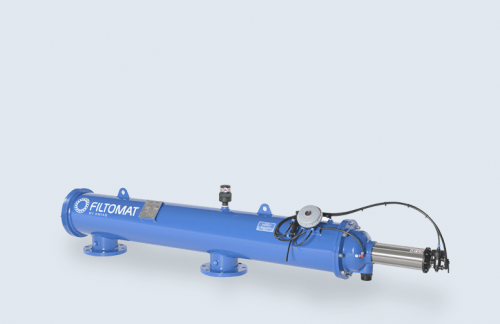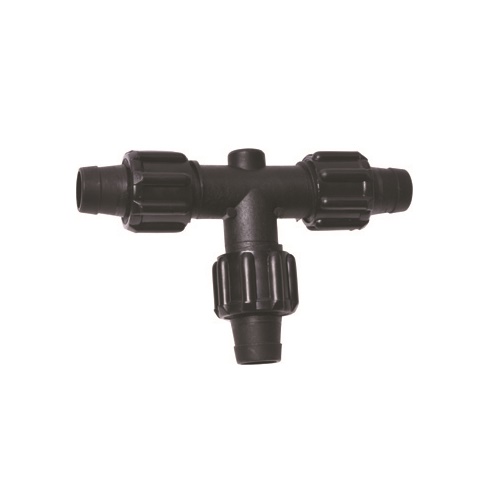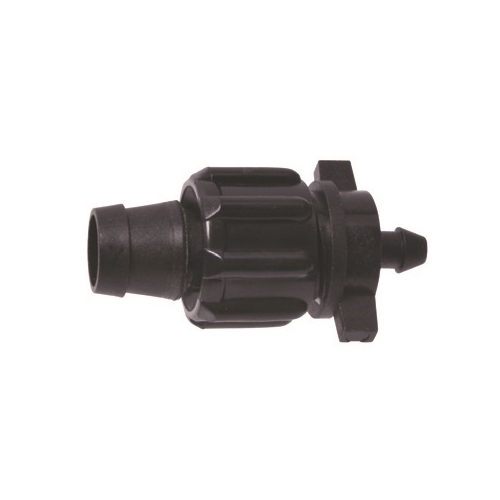Description
What is a Plastic Spin Clean Y-Filter?
This is a screen-type filter with a Y-bodied configuration (hence “Y-filter”), manufactured by Jain (or branded similarly) and called a “Plastic Spin Clean Filter”. The key attributes:
-
The housing is engineered plastic (light, corrosion-resistant) rather than metal.
-
It uses a “Spin Clean” action: as water flows through, debris is swept across the screen and down into a debris-basin (flush port) without needing a rotating mechanical part.
-
It’s offered in sizes like ¾″, 1″, 1½″, 2″ etc for drip/mini/inline irrigation applications.
So in plain commercial irrigation parlance: this is a compact, low-maintenance screen filter you install in your irrigation supply line (often immediately before the drip or micro-irrigation laterals or manifolds) to trap sand and other particulate debris, with a convenient flush capability.
What is it used for?
Here’s how and why you would deploy this filter:
-
Particulate removal: If your source water has sand, silt, rust scale, algae flakes, or other suspended particles, these can clog drip emitters, laterals, micro-sprinklers and cause flow variability. A screen filter protects those downstream components. As noted in a “beginners guide” to irrigation filters: “A spin clean filter is a unique type of irrigation filter that stays clean while it’s in operation. These filters move debris, especially sand, across a screen and into a basin where it can be collected and drained.”
-
Prevention of downtime / emitter blockage: For farmers and commercial irrigators, fewer clogs mean fewer service calls, less emitter replacement, and more consistent water delivery to plants (which affects yield).
-
Ease of maintenance: Because the “Spin Clean” mechanism keeps the screen sweeping debris and the housing has a flush port, it reduces manual cleaning frequency (versus a plain static screen that you have to remove/clean often). The manufacturer states: “No moving parts … Unique Spin Clean® action keeps the screen clean during operation.”
-
Lightweight & corrosion resistant: The plastic housing is beneficial especially for fertilizer-injected systems or where water chemistry is aggressive. From the spec sheet: “Engineered plastic construction is light in weight and resistant to corrosion and injected chemicals.”
This is a cost-efficient “insurance” filter for drip/micro systems to maintain uptime and protect emitters, especially when using recycled/surface water or pivot return water where particulate load is higher.
Key Features & Benefits
Here’s a table of salient features + benefits (and some caveats) you could use in product datasheets or your website.
| Feature |
Benefit |
Notes / Caveats |
| Plastic (engineered) housing |
Lighter weight, easier to install, resistant to corrosion/chemicals |
Plastic still has pressure / temperature limits; check rating. From specs it supports up to 150 psi in certain models |
| Spin Clean action (no moving parts) |
Less mechanical wear, simpler maintenance, debris is swept into flush basin while system runs |
Requires proper pressure differential (approx 5-8 psi across screen) for best effect. From spec: “Only 5-8 psi pressure loss required across filter to ensure best self cleaning action. |
| Two-piece housing with O-ring seal |
Easy screen access for inspection/cleaning |
Even with “self cleaning” you still need to inspect screen periodically. |
| Stainless steel screen elements (various mesh sizes: 30, 50, 100, 150, 200) |
Flexibility to match particle size load; higher mesh = finer filtration |
Finer mesh increases pressure drop and cleaning load. Choose wisely. |
| Flush port / ball valve to drain debris basin |
Allows easy manual flush of accumulated debris without disassembly |
Customer must schedule flush; bypass not automatic. |
| Y-filter configuration |
Allows installation in a configuration that facilitates flush debris downward into basin/port |
When installed properly orientation matters (see below). |
| Suitable for drip/micro irrigation upstream of laterals |
Protects small-emitter systems and reduces maintenance downtime |
Not always suitable as sole filtration for heavy dirty water — sometimes a sand separator or media filter upstream is needed. |
Additional benefits
-
Lower maintenance labor cost (less downtime, fewer clogged laterals)
-
Reduced emitter replacement cost
-
Possibly reduced water-waste (if emitters clog, you may over-irrigate or lose pressure)
-
Improved consistency of water delivery which affects crop yield and uniformity
Things to watch
-
Although it requires less maintenance than older screen filters, it is not totally maintenance-free. If the pressure differential gets too high it loses its self-cleaning efficiency. The spec sheet says cleaning interval should be triggered when differential rises.
-
If source water is very dirty (high sand/silt load or organic debris), you may need coarse pre-filtration (e.g., sand separator) upstream so that the spin-clean screen isn’t overloaded.
-
Pressure drop: While the device aims for only 5-8 psi drop when clean, as it loads up the drop increases; you must monitor.
-
Plastic housing has pressure/temperature limits; verify size/rating for your system (some models rated at 80 psi, others 150 psi).
-
Y-filter orientation and space for flush/drain must be planned (the basin must have clearance for removal or flush).
-
Mesh size choice: Too fine may cause frequent maintenance; too coarse may allow unwanted debris through.
How to use / install it (step-by-step)
Here’s a practical guide for your commercial drip-irrigation clients (or for your own technical specs) on how to install and maintain a Plastic Spin Clean Y-Filter.
Installation
-
Select size/mesh
-
Determine flow rate of the line and expected particle load; choose port size (¾″, 1″, 1½″, 2″) appropriate for flow.
-
Choose screen mesh based on particle size. If water has heavy sand (say 100 mesh or 150 mesh might be appropriate).
-
Verify pressure rating meets system working pressure.
-
Positioning & orientation
-
The “Y” body portion (the debris basin / flush port) should be downward (gravity continues to pull debris into basin). The main “through” pipe should be horizontal (or as recommended by manufacturer). From spec: “The Spin Clean shall be installed in the pipeline with the ‘Y’ end facing downstream.”
-
Make sure you have clearance under the flush port/basin so that you can drain debris and remove screen if needed.
-
Install upstream of the emitter / lateral manifold, after any coarse pre-filtration if required.
-
Connectivity
-
Threaded connections: two-piece housing with O-ring seal. Use proper pipe sealant/threads consistent with irrigation pipe material.
-
If a flush valve is provided, connect flush line or allow for manual flushing.
-
Commissioning
-
Start system, allow steady flow. Ensure inlet pressure minus outlet pressure (i.e., pressure drop across the filter) is within 5-8 psi (when clean) as recommended to maintain the “spin clean” action. If differential is too low, cleaning action may not work well; if too high, screening may be loaded.
-
Check downstream emitters/uniformity to ensure filter is performing.
Routine Use & Maintenance
-
Monitor differential pressure
-
Install pressure gauges before and after the filter (or at inlet and outlet). When differential rises significantly above ~5-8 psi, it’s time to flush/inspect.
-
Manufacturer spec: “Care should be taken to keep the operating pressure differential across the filter between 5-8 psi.”
-
Flush debris basin
-
Open the flush/ball valve at the basin to drain accumulated debris. This should be done periodically — more often in high-particulate water situations.
-
Remove the basin cap and remove any large debris if manual cleaning is required.
-
Inspect screen
-
At scheduled intervals (based on particle load) shut down flow, relieve pressure, remove housing cover, extract screen, and spray clean (from outside-in) using a pressure washer or hose with good pressure. Spec sheet: “The screen element should be washed thoroughly using a high pressure spray washer, spraying from outside in.”
-
Reinstall screen and O-ring; ensure sealing.
-
Record maintenance
-
For commercial irrigation systems you may keep a log of differential pressure, flush intervals, any replacement of mesh/screen, to show your farmers/clients you’re proactive.
-
Season shut-down / winterizing
-
If system is drained for winter, flush out the filter, remove and clean screen, and protect housing from freezing if applicable (even though plastic handles freeze-thaw better than metal, you still want to avoid ice damage).
Application Tips
Pros
-
“Set-and-forget” type filter for drip/micro systems: Less frequent manual cleaning thanks to the spin cleaning action.
-
Lightweight plastic means easier installation and less risk of corrosion (important in fertilizer/micronutrient injection systems).
-
Many sizes and mesh options mean flexibility (from smaller emitter systems up to larger inline manifold flows).
-
Helps reduce downstream emitter problems (which are costly, time-consuming, and reduce yield) — a good value-sell.
-
Flush capable — gives the end‐user a visible maintenance point and piece of mind.
-
Aligns with your content marketing strategy: “Reduce downtime, protect your drip investment, maintain yield uniformity” — gets the farmer’s attention.
Cons
-
If water quality is extremely poor (very high sand load, heavy organic debris) this alone may not suffice — you may need a sand separator and this filter as secondary protection.
-
If the differential pressure runs too high (screen loading), performance diminishes; the irrigation manager must watch for this — so it’s not totally “hands off”.
-
If installed incorrectly (wrong orientation, inadequate clearance for flush basin), you risk under-performance or early plugging.
-
Mesh size selection is important: the farmer may be tempted to choose ultra-fine mesh but that increases maintenance and pressure drop. You’ll want to advise choosing the “right size for particle load” not just “smallest mesh”.
-
Plastic has limits: verify whether the model selected is rated for the system pressure and whether chemical exposure (fertigation) is within compatibility.
